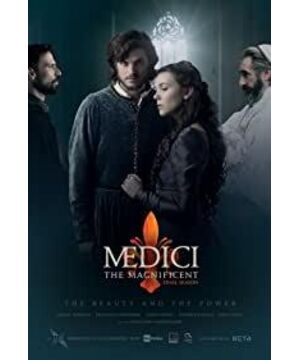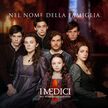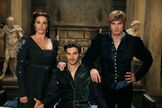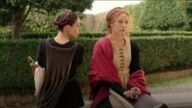The series follows the mysterious death of Giovanni from the past to the future, dating back to the early 15th century. It describes that the Roman Catholic Church was in a period of chaotic schism. A former pirate living in the church felt that the time was not right, so he took the opportunity to come to Florence. The Medici family bank sought funding to run for the Pope, Baldassare Cossa, later Pope John XXIII (Pope John XXIII). After the new pope ascended the throne in 1410, the banking business of the Medici family was also supported because of their great contribution to the election. As a result, the business flourished, and the family began to be rich and powerful. Dustin Hoffman as Giovanni is a bit overkill. Hoffman's acting skills were not released in the limited flashback episodes, but the use of big-name actors must have won a lot of attention for the show's promotion. . After explaining the basic state of the Medici family, the story gradually focuses on the brother who lost his father.
The Medici family has a strange tradition of repeating names from generation to generation, such as Averardo, Giovanni, Cosimo and Lorenzo appearing frequently in the family tree. Lorenzo is a particularly valued name among them, because the Medici family lived near the Basilica di San Lorenzo after they came to Florence, so they regarded the Basilica of San Lorenzo as a blessing after their fortune. Blessed land, only the most extraordinary children can be named after. The Lorenzo in this play is called the old Lorenzo, thus distinguishing Lorenzo the Magnificent, the descendant of the high Renaissance. From this, it seems that Lorenzo had high hopes when he was young. However, as the years changed, Giovanni gradually relied on his eldest son Cosimo, and Cosimo really lived up to the expectations of his parents. Cosimo is played by "The Game of Throne" "Teen Wolf" Richard Madden. The heroic and upright Madden interprets Cosimo very well in two periods separated by 20 years. He has grasped the ignorance and impulsiveness of youth and the majesty and wisdom of middle age. The only fly in the ointment is that the age difference between the two stages is on his face. There is not much manifestation.
The Medici family's surname Medici literally means pharmacist, which directly gives the family's living state before its prosperity, which is also reflected in their family emblem. It is said that the raised red balls on the family emblem represent the pills. The pills were originally 12, but later reduced to 8 and then reduced to 6. In another version, there are 5 red pills and one blue pill (on the blue pill). There are three golden lilies, it is the king of France Louis XI
Political enemies have been slandering the Medici family for making usury profits. In fact, the original sin of this capital accumulation is also torturing Cosimo's heart. Not to mention the stifled love, the sudden death of the father, the harshness of the mother and the power struggle. These inner torments, coupled with Cosimo's own qualities, have fermented under the smear of the bud of humanism. Cosimo increasingly resorted to emotional catharsis to art. Just as Schopenhauer made the conclusion 400 years later: aesthetics and art are tools to relieve the pain of life. And this is probably the fundamental reason why the Medici family contributed to the European Renaissance. In the first episode, Cosimo, who loves art, meets his first love while accompanying his father in lobbying to bribe church officials. Immediately in the second episode, the master-level Brunelleschi (Filippo Brunelleschi) appeared. Michelozzo is mentioned again in a later episode. There are also two great works of art in the opening sequence of the series, one is the dome of the Basilica di Santa Maria del Fiore. According to the time point of the plot, the church at this time has not yet been capped. , and the dome roof was designed and built by Brunelleschi; the other is Donatello's handed down bronze sculpture "David".
Brunelleschi in the series is handsome, but in fact he is bald and fat, described as wretched, sharp, surly, irritable, but ugly and evil words can't hide this person's extraordinary talent. Giovanni Medici and Cosimo Medici have always supported Brunelleschi with their love of talents and encouraged him to participate in the solicitation of the dome of the Cathedral of Santa Maria del Fiore, and thus produced the famous The story of "Egging the Egg" is faithfully reproduced in the play. In 1420, after repeated lobbying by Brunelleschi, the church finally delivered the dome design to him. In 1436, the master craftsman Brunelleschi did his own work, following the structure of the ancient Roman-style classical city, reminiscing about the ancients, and making the lost classical architectural wisdom shine again in Florence. , this classical regeneration made it possible to complete the dome of the Cathedral of Our Lady of the Flowers. In the West, the completion of this dome marked the beginning of the European Renaissance.
At that time, in Florence, the art of sculpture was scarce, and Donatello had the characteristic character of the artist: manic and eccentric. His sculpture works are sold only when they meet people who know the goods. If they meet people who don't know the goods, they will directly destroy the works in front of them. As a result, Donatello and his disciples often lived in hardships, making it difficult to continue. Cosimo was very skilled in carving. In order to keep Donatello in his art career, Cosimo often commissioned him to make church carvings. In 1443, Cosimo commissioned Donatello to create the bronze statue "David" out of his admiration for ancient Roman art and the bravery of his ancestor Avilado against the giant Mugello. When the life-size bronze sculpture "David" came out, there was an uproar in public opinion. In the play, the time of the statue's appearance was brought forward by the writers by 20 years, and it appeared as a major incrimination of Cosimo's support for same-sex love. At that time, the work was the first upright nude male statue in history since ancient Rome. Zuo is the patron saint of the family). The bronze statue has no strands except for the crown, helmet and boots. David is leaning on a sharp sword in his hand, looking down, and under his feet is the head of Goliath wearing a war helmet. It is extremely paradoxical that a cluster of decorative feathers on Goliath's helmet is close to David's bare legs from bottom to top, like a tender caress, and points directly at David's lower body, which is very sensual. The work was despised for a while, but Cosimo's attitude was not changed by the world. He even ignored the teachings and canons of Catholicism, and highly recognized this subversive work. It was this spirit that provided the artists of the time with the space to innovate, and a lot of real art was born. But at that time, art was ultimately in the service of politics. Cosimo erected the bronze sculpture "David" in front of the Medici Palace, which is a symbol of the Quanhao family and represents the victory of justice over tyranny. At that time, people criticized him for showing off his extravagance. In order to maintain the image of the family, Piero Ⅰ Medici, the son of Cosimo, wrote a poem explaining that the bronze statue was standing up against arrogance. Said: "Empires decline and fall in arrogance, city-states thrive on virtue, look at the proud head cut off by humble hands."
Unexpectedly, decades later, David continued to entangle with the Medici family in different artistic images. In 1504 AD, Michelangelo had been immersed in the artistic circle of the Medici family for many years. He had witnessed the power struggle between the posh Lorenzo and other noble families, and gradually saw this man who was supported by money. The essence of the court of power. Therefore, when his son and nephew were exiled after Lorenzo's death, he left the giant family without hesitation. This rebellious emotion was also vented by him in the sculpture "David". This work embodies the image of David glaring at the giant Goliath, ready to fight with gravel in his hand. "David" was originally commissioned by the Cathedral of Santa Maria del Fiore to be placed at the top of the church, and when people see this intricately carved work, they are all astonished. In order to make this extraordinary beauty often seen and admired, "David" was finally placed outside the Florence City Hall. As the location changes, the meaning given to the statue changes accordingly. If placed on the top of the church, David is the symbol of the religious prophet and the Medici family; if placed in front of the city hall, David has become the symbol of the city of Florence. At this time, the republic was in the limelight in Florence. The exile of the Medici family was hailed as the defeated owl of the giant Goliath. The struggle of the Florentine people was like David's victory over the weak and the strong. In order to defeat the Medici and support the republic in season. Since Donatello's "David" bronze statue, David has been associated with the Medici family again, but the alternation of status symbols caused the prosperity of the time to decline relative to the current time, which is embarrassing. people. According to the routine of the title of the first season, the title design of "The Medici Family: The Emerald Famous Door" will definitely appear in the title design of the new season's episodes.
Public number: Ding Shendeng
View more about Medici reviews










